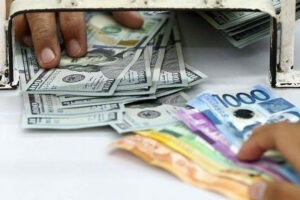




Philippines Trade Update: Trade trajectories trend along
 DOWNLOAD
DOWNLOAD

Policy Rate Updates: Double cut finale
 DOWNLOAD
DOWNLOAD

Monthly Economic Update: One for the road
 DOWNLOAD
DOWNLOAD


Peso won’t derail rate cuts in Q4

The Philippine central bank would cut its key rate as early as the fourth quarter despite the peso’s slide to a 17-month low, according to Governor Eli M. Remolona, Jr.
The Monetary Board might still cut policy rates in the fourth quarter, he told a news briefing on Wednesday. “If things are worse than we think, that might be postponed to the first quarter of 2025.”
The peso and other regional currencies have weakened in recent days as markets bet against the odds of early rate cuts around the world.
The peso depreciated past the closely watched PHP 57-a-dollar level on Tuesday before closing at PHP 57 flat — the weakest since PHP 57.375 on Nov. 22, 2022 — due to expectations that the US Federal Reserve would delay cutting interest rates.
It continued to weaken on Wednesday, closing at PHP 57.18 against the greenback.
Mr. Remolona said the peso’s depreciation has not been big enough to affect inflation expectations and monetary policy.
“I wouldn’t say it’s performing poorly,” he said. “I would say it’s adjusting to some events. It initially weakened, along with other emerging market currencies, by the way, because of what’s going on in the Middle East.”
Markets were rattled after Iran launched hundreds of drones and missiles against Israel at the weekend in retaliation for an alleged airstrike by Israel on the Iranian consulate in Syria earlier this month.
But the Bangko Sentral ng Pilipinas (BSP) chief sees no threat from the conflict.
“In fact, the price of Brent oil and Dubai oil initially went up, but now has settled back down,” he said. “So, the sense of the oil market is that hostilities will not escalate. I hope it stays that way.”
Brent futures for June fell by 0.44% or 40 cents to USD 89.62 a barrel by 6:32 a.m. GMT, while US crude futures for May fell by 0.56% or 48 cents to USD 84.88 a barrel, Reuters reported.
Mr. Remolona said the peso’s recent drop had been due to signals of rate cut delays by the Fed.
“There’s a postponement of when the FOMC (Federal Open Market Committee) will ease, in the eyes of the market,” he said. “That has meant weakening of other currencies against the US dollar.”
“It’s not a case of a weak peso, it’s a case of a strong dollar. Unless the movements are very sharp, we tend to allow the adjustment to happen,” he added.
Federal Reserve Chairman Jerome H. Powell has said they might have to keep “restrictive” policy rates for longer amid sticky inflation.
NO RATE HIKE
Markets were initially anticipating the US central bank to begin cutting rates by June, but this could get delayed to as late as September.
“Easing won’t happen until maybe late in the third quarter when it comes to the FOMC,” Mr. Remolona said. “The US inflation rate has remained very stubborn.”
The Fed hiked its fund rate by 525 basis points (bps) from March 2022 to July 2023 to 5.25-5.5%.
Mr. Remolona said there won’t be any rate increases this year unless inflation quickens faster than anticipated.
Inflation sped up for a second straight month to 3.7% in March from 3.4% a month earlier. The BSP expects inflation to average 3.8% this year.
“What is scary is the de-anchoring,” Mr. Remolona said. “When we see that the markets and households begin to believe that inflation will surge, then we have to consider a rate hike.”
“But otherwise, we’re tight now. At 6.5%, it’s already tight. It’s already doing its work,” he added.
The central bank stood pat for a fourth straight meeting in March, keeping its benchmark rate steady at a near 17-year high of 6.5%. The Monetary Board raised borrowing costs by 450 bps from May 2022 to October 2023.
Meanwhile, Fitch Solutions unit BMI said the peso might continue to depreciate in the next six months to two years amid weak economic fundamentals.
“In the longer term, the currency will stay on its depreciatory trend, weakening to P57.20 per dollar by end-2025,” it said in a report.
Elevated inflation will temper the currency’s appreciation, it said. “Emerging markets such as the Philippines generally see quicker price increases compared with advanced economies.”
“Higher inflation in the Philippines may lead to a steady decline in the peso’s value to preserve the country’s competitiveness internationally,” it added.
BMI said it expects the peso to come under much volatility in the short term due to the constant repricing of interest rate expectations in the US.
“However, we think that this will eventually fade once the US Federal Reserve embarks on its first cut in July,” it said. “This means that the Philippine peso will remain somewhat stable at P56.50 per dollar [by yearend].”
Philippine economic managers expect the peso to trade from P55 to P57 this year and from P55 to P58 from 2025 to 2028. – Luisa Maria Jacinta C. Jocson, Reporter
This article originally appeared on bworldonline.com





 By BusinessWorld
By BusinessWorld